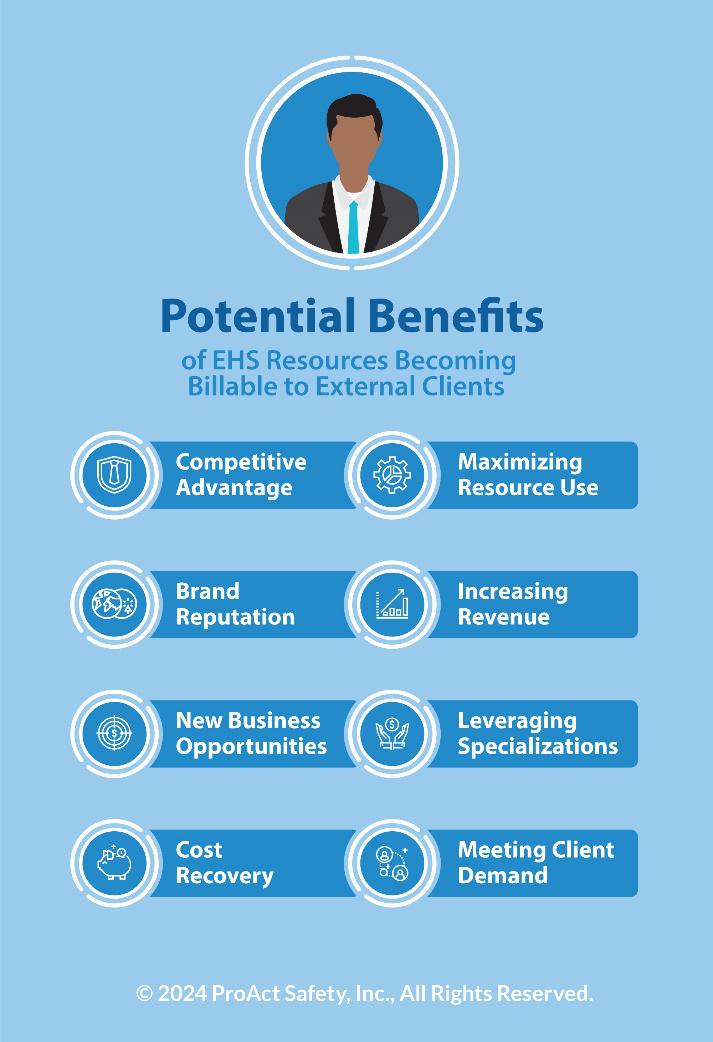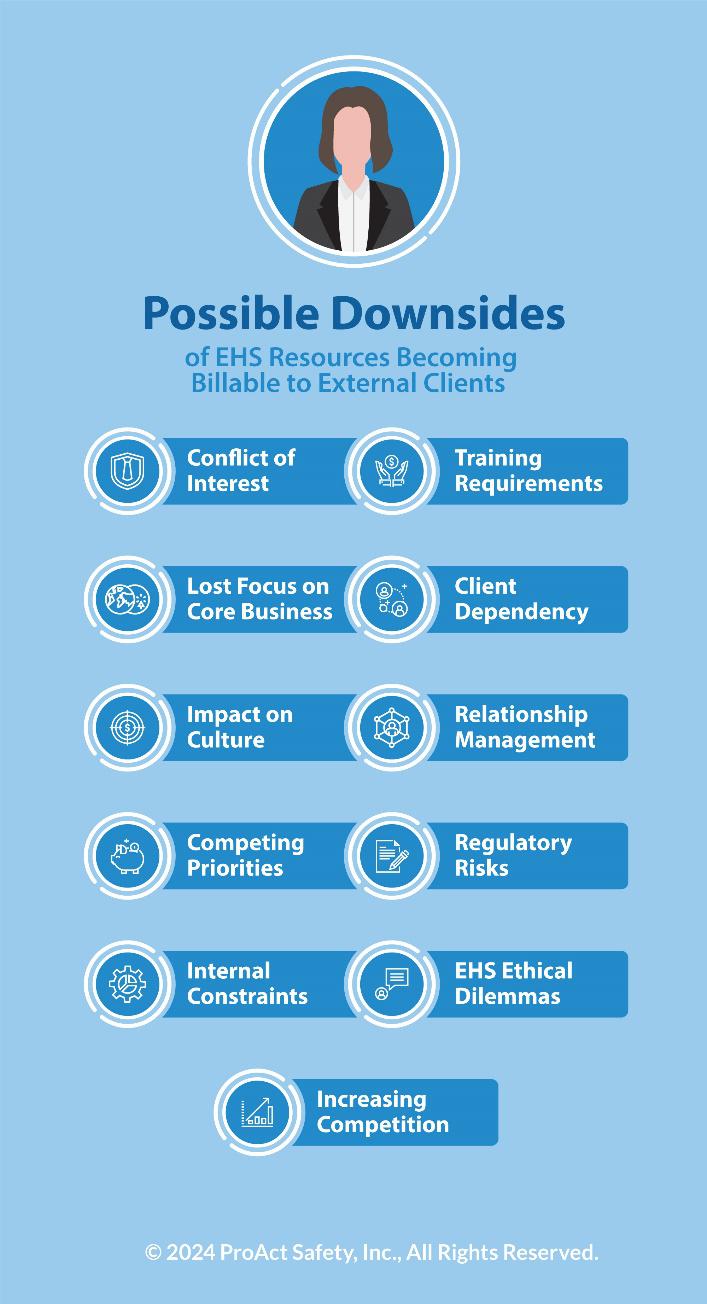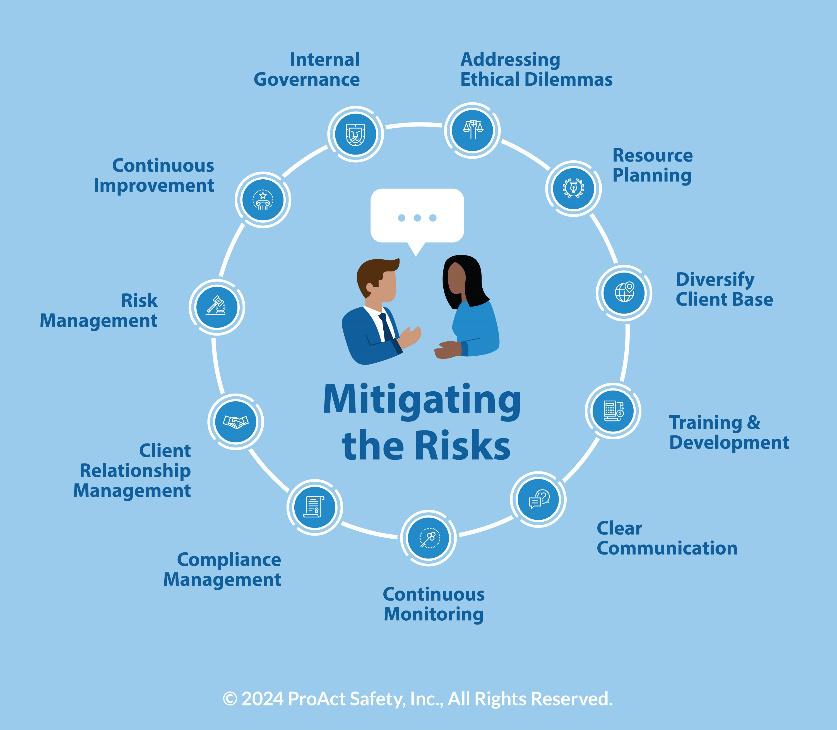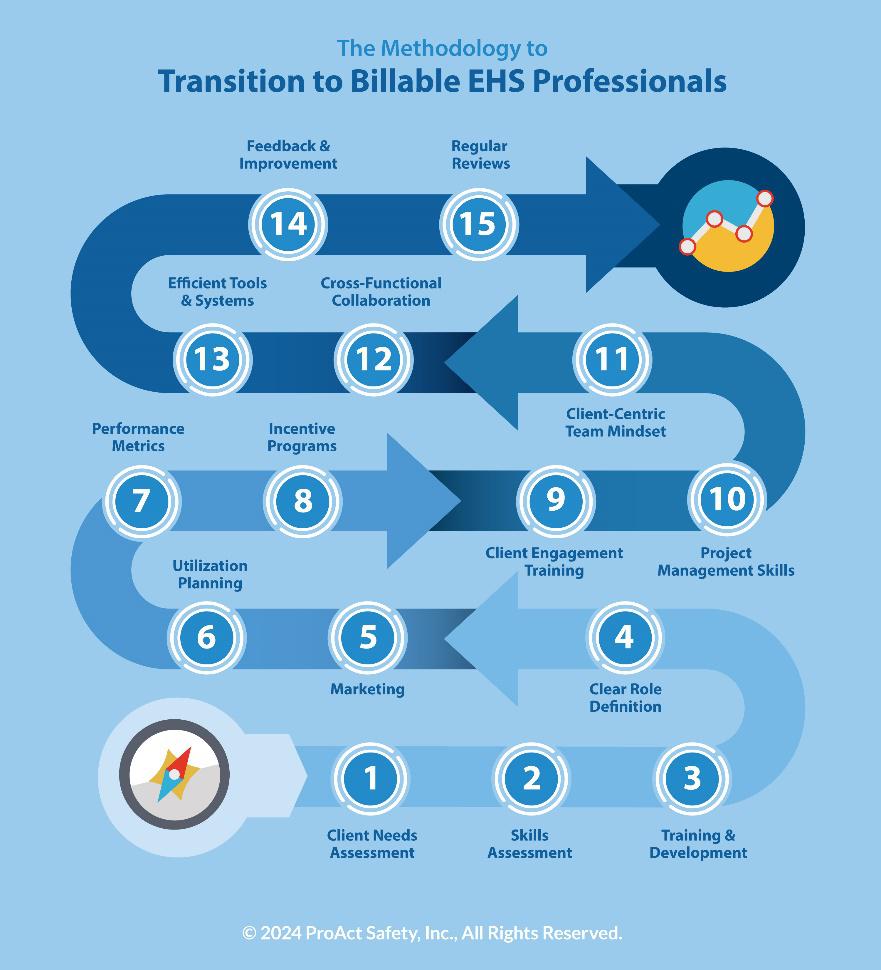Professional Safety - August 2024
By: Shawn M. Galloway
Printable Version
As an organization’s dedication to workplace safety matures, the EHS professionals move from being perceived as administrators to subject-matter experts and from necessary cost centers to value-added functions enabling business success. With the ever-changing business landscape, companies are constantly seeking ways to differentiate, create new competitive advantages and maximize profitability, some by leveraging their internal resources to do so.
Some companies employ a strategy to transition their Environmental, Health, and Safety (EHS) resources into billable professionals who can provide services to new or existing clients. This is especially an option for an organization that is already a service-based enterprise. While there are some significant advantages to this approach, there are vital consequences that organizations must consider and proactively address. This article contains three parts: Exploring the pros and cons of this approach, the steps to take to mitigate the potential negative consequences, and providing a methodology to follow to implement this transition.
Part 1: Pros and Cons
There are several major reasons why an organization would benefit from or might need to move its internal EHS resources to become billable to external clients.
 Here are the Pros:
Here are the Pros:
Maximizing Resource Utilization: By transitioning EHS resources to become billable professionals, organizations can maximize the utilization of their internal resources. This allows the organization to generate revenue from its EHS team's expertise and skills rather than solely relying on its internal operations.
Increasing Revenue Streams: Organizations can create additional revenue streams by offering EHS services to external clients. This income diversification can help the organization expand its overall profitability and financial stability.
Leveraging Specialized Expertise: EHS professionals often possess specialized knowledge and expertise in environmental compliance, health and safety regulations, and risk management. By offering these services to external clients, organizations can leverage their EHS team's expertise and provide valuable solutions to clients who may not have the same level of in-house knowledge.
Meeting Client Demand: There is often a high demand for EHS services from external clients who may not have the resources or expertise to handle these matters internally. By transitioning EHS resources to become billable professionals, organizations can meet this demand and provide valuable services to clients who require assistance with EHS compliance and management.
Gaining a Competitive Advantage: Offering EHS services to external clients can give organizations a competitive advantage in the market. By showcasing their expertise and track record in delivering EHS solutions, organizations can differentiate themselves from competitors and attract new clients.
Enhancing Brand Reputation: Providing EHS services to external clients can enhance an organization's brand reputation. By demonstrating a commitment to environmental sustainability, workplace safety, and regulatory compliance, organizations can build a positive reputation in the industry and attract clients who value these principles.
Developing New Business Opportunities: Engaging with external clients through EHS services can open new business opportunities for organizations. By establishing relationships with clients who require EHS support, organizations may have the chance to expand their services and offer additional solutions in related or even unrelated areas.
Cost Recovery: In some cases, organizations may have invested significant resources in developing their internal EHS capabilities. Organizations can recover some of these costs by transitioning these resources to become billable professionals and ensuring that their EHS team's expertise is utilized effectively.
While there are many benefits to transitioning internal EHS resources to become billable to external clients, there are also some potential downsides to consider.
These Cons include:
Internal Resource Constraints: Transitioning internal EHS resources to become billable professionals may reduce available resources for internal operations. This could impact the organization's ability to manage and address internal EHS needs and compliance requirements effectively.
Competing Priorities: When EHS resources are focused on billable client work, there may be competing priorities between client projects and internal EHS initiatives. This can lead to challenges balancing external clients' needs with the organization's internal EHS requirements.
Potential Conflict of Interest: Transitioning internal EHS resources to become billable professionals may create potential conflicts of interest. EHS professionals may need to navigate situations where their obligations to external clients may conflict with their responsibilities to the organization, leading to ethical dilemmas.
Loss of Focus on Core Business: Depending on the extent of the transition, there is a risk that the organization may lose focus on its core business activities. If too many internal resources are allocated to billable client work, it may detract from the organization's ability to focus on its primary products or services.
Client Dependency: Relying heavily on billable EHS services to external clients can create a dependency on a limited number of clients. If these clients reduce their demand for EHS services or terminate their contracts, it can significantly impact the organization's revenue and financial stability.
 Increased Competition: Transitioning internal EHS resources to become billable professionals may lead to increased competition in the market. Organizations may compete with specialized EHS consulting firms or other organizations offering similar services, potentially impacting pricing and market share.
Increased Competition: Transitioning internal EHS resources to become billable professionals may lead to increased competition in the market. Organizations may compete with specialized EHS consulting firms or other organizations offering similar services, potentially impacting pricing and market share.
Skill Set and Training Requirements: Transitioning internal EHS resources to become billable professionals may require additional skill sets and training. EHS professionals may need to develop business development, client management, and project management skills to effectively deliver billable services, which can require additional investment in training and development.
Client Relationship Management: Managing client relationships and expectations can be challenging, especially if the organization is new to providing billable EHS services. Building and maintaining strong client relationships requires effective communication, responsiveness, and consistently meeting client expectations.
Regulatory Compliance Risks: Organizations may face additional regulatory compliance risks when providing EHS services to external clients. Ensuring that the organization and its billable EHS professionals are up to date with relevant regulations and have the necessary expertise to navigate compliance requirements is essential.
Impact on Company Culture: Transitioning internal EHS resources to become billable professionals can impact the company culture. Employees may need to adapt to a more client-focused mindset, which can change the dynamics and values within the organization.
Ethical Dilemmas for the EHS Professionals: Concluding with this consideration is intentional due to the multifaceted points that must be covered:
- Conflict of Interest: EHS professionals are primarily responsible for protecting their organization's employees' health and safety and ensuring compliance with environmental and safety regulations. If they are also serving external clients, there may be situations where the interests of the client conflict with the interests of their employer. This could lead to ethical dilemmas where EHS professionals must choose between serving their client's or employers' interests.
- Confidentiality: EHS professionals often have access to sensitive information about their organization's operations, such as proprietary processes, safety data, and risk assessments. If they are serving external clients, there may be concerns about maintaining the confidentiality of this information, especially if the clients are competitors.
- Professional Integrity: EHS professionals have an ethical duty to provide competent and objective services. Suppose they are under pressure to generate revenue from external clients. In that case, they may feel tempted to compromise their professional standards, such as overcharging for services, exaggerating the need for certain services, or providing services outside their area of expertise.
- Independence: EHS professionals must maintain independence to assess risks, recommend controls, and ensure compliance effectively. If their performance is evaluated based on the revenue they generate from external clients, their independence could be compromised, and they may feel pressured to make decisions that favor the client's or the organization's financial interests over safety and compliance.
It is essential for organizations to carefully consider these potential downsides before making the executive decision to pursue this as part of the growth strategy.
 Part 2: Mitigating the Cons
Part 2: Mitigating the Cons
To mitigate the risks associated with transitioning internal EHS resources to become billable to external clients, organizations can take several steps:
Addressing Ethical Dilemmas: EHS professionals should be supported and encouraged to adhere to their professional code of ethics, which typically includes principles such as integrity, competence, respect for confidentiality, and commitment to safety and health. They should also be encouraged to communicate openly with their employer about potential conflicts of interest and to seek guidance from internal or external resources when faced with ethical dilemmas.
Resource Planning: Develop a comprehensive resource planning strategy considering internal EHS needs and billable client work. This ensures a balance between the two and that internal operations are not compromised.
Clear Communication and Expectations: Clearly communicate the expectations and responsibilities of EHS professionals involved in billable client work. Ensure that they understand the potential conflicts of interest and the importance of prioritizing internal EHS needs when necessary.
Training and Development: Provide training and development opportunities to EHS professionals to enhance their skills in areas such as business development, client management, and project management. This equips them with necessary skills and significantly increases in confidence to deliver billable services while managing potential risks effectively.
Diversify Client Base: Avoid relying too heavily on a limited number of clients for billable work. Diversify the client base to reduce the risk of dependency on a single or small group of clients. This can be achieved through targeted marketing and business development efforts.
Continuous Monitoring and Evaluation: Regularly monitor and evaluate the performance of billable EHS services to ensure that they align with the organization's goals and objectives. This includes monitoring client satisfaction, billable hours, and financial performance. Use this information to make informed decisions and adjustments as needed.
Compliance Management: Stay current with relevant regulations and ensure that billable EHS services comply with all applicable laws and regulations. Develop robust compliance management systems and processes to mitigate regulatory risks.
Client Relationship Management: Build strong client relationships based on trust, open communication, and responsiveness. Regularly engage with clients to understand their needs and expectations and address any concerns promptly. This helps mitigate the risk of client dissatisfaction or loss of business.
Internal Controls and Governance: Implement internal controls and governance mechanisms to manage potential conflicts of interest and ensure that billable EHS services are delivered ethically and in line with the organization's values. This includes establishing clear guidelines for managing conflicts and ensuring transparency in decision-making processes.
Continuous Improvement: Foster a culture of continuous improvement by soliciting feedback from clients, internal stakeholders, and billable EHS professionals. Use this feedback to identify areas for improvement and implement necessary changes to enhance the quality and effectiveness of billable services.
Risk Management: Develop a comprehensive risk management strategy that identifies and addresses potential risks associated with transitioning internal EHS resources to become billable professionals. This includes conducting risk assessments, implementing risk mitigation measures, and regularly reviewing and updating the risk management plan.
By implementing these steps, organizations can effectively mitigate the risks associated with transitioning internal EHS resources to become billable to external clients. This allows them to maximize the benefits of offering billable EHS services while minimizing potential drawbacks.
Part 3: Methodology to Transition to Billable EHS Professionals
Once an organization has recognized the benefits, reviewed the disadvantages, and successfully developed a plan to mitigate the challenges ahead, the following outlines the steps recommended to pursue this course of action.
 Client Needs Assessment: The first step in optimizing the transition of EHS resources to billable professionals is to thoroughly assess client needs. This involves identifying opportunities for EHS billable services that can provide a marketable competitive advantage for the company. By understanding clients' specific needs and demands, organizations can tailor their services to meet those requirements and generate interest in their offerings.
Client Needs Assessment: The first step in optimizing the transition of EHS resources to billable professionals is to thoroughly assess client needs. This involves identifying opportunities for EHS billable services that can provide a marketable competitive advantage for the company. By understanding clients' specific needs and demands, organizations can tailor their services to meet those requirements and generate interest in their offerings.
Skills Assessment: Next, it is crucial to evaluate the skills and capabilities of the EHS staff to identify areas where they can provide billable services. This assessment will help determine the match between the staff's skill sets and clients' needs. By leveraging the existing expertise within the EHS team, organizations can maximize the value they offer clients and increase their billable hours.
Training and Development to Align with Client Needs: Once the skills assessment is complete, organizations should provide training and development opportunities to address any gaps and enhance the skills of the EHS staff. This training should be aligned with client-specific needs to ensure that the staff can effectively deliver billable services. By investing in the professional development of the EHS team, organizations can enhance their capabilities and deliver high-quality services to clients.
Clear Role Definition: To optimize the transition to billable professionals, it is essential to clearly define roles and expectations for the EHS staff in billable projects. This includes ensuring they understand their responsibilities and how their contributions directly impact client deliverables and satisfaction. Clear role definition helps create a sense of purpose and accountability among the team, leading to improved performance and client satisfaction.
Marketing: To generate market interest in the EHS billable services, organizations should work with internal or external resources to reposition the company's brand. This involves effectively communicating the value proposition of the EHS services and highlighting the expertise and capabilities of the EHS team. Organizations can attract potential clients and increase their billable projects by implementing targeted marketing strategies.
Effective Utilization Planning: Optimizing EHS utilization is crucial for maximizing billable hours. Organizations should implement effective resource planning to balance workloads and allocate resources efficiently. This ensures that the EHS staff is fully utilized and can deliver billable services without compromising quality or client satisfaction.
Performance Metrics and KPIs: Establishing performance metrics and key performance indicators (KPIs) related to billable hours is essential for monitoring progress and driving performance. Regularly monitoring and communicating these metrics helps keep the EHS team focused on achieving billable targets and enables organizations to identify areas for improvement.
Incentive, Reward, and Recognition Programs: Creating a motivational environment among the EHS team is crucial for promoting billable hours and project success. Organizations should determine the best approaches to incentivize, reward, and recognize the team's efforts in delivering billable services. It is essential to strike a balance between motivating the team and ensuring that internal customer needs are still addressed and served effectively.
Client Engagement Training: Providing training to the EHS team on effective client communication and engagement is essential for building strong client relationships. Equipping the team with the skills to manage client expectations and address their needs effectively will enhance client satisfaction and increase the likelihood of repeat business.
Project Management Skills: Enhancing the project management skills of the EHS staff is crucial for delivering internal and external projects on time and within scope. Organizations should invest in training and development programs that improve the team's ability to handle client projects from initiation to completion. This includes effective planning, resource allocation, and risk management.
Promote a Client-Centric Team Mindset: Instilling a client-centric mindset among the EHS staff is vital for delivering exceptional service. Emphasizing the importance of client satisfaction and building long-term relationships with internal and external clients helps create a culture that prioritizes client needs. This mindset drives the team to go above and beyond in delivering billable services.
Cross-Functional Collaboration: Fostering collaboration between the EHS staff and other client delivery teams is crucial for seamless service delivery. Encouraging a seamless flow of information and resources enhances overall service delivery to clients. By working with other teams, the EHS staff can leverage their expertise and contribute to the organization's overall success.
Efficient Tools and Systems: Learning from other service delivery areas, organizations should provide the EHS team with efficient tools, technology, and systems that streamline their work processes and client delivery. By leveraging technology and automation, organizations can optimize the efficiency of the EHS team and increase their capacity to deliver billable services.
Feedback and Improvement: Establishing a feedback loop is essential for continuously improving billable service delivery. Organizations should solicit feedback from external clients, other client delivery teams, and internal teams to identify areas for enhancement. This feedback helps identify strengths and weaknesses and guides the implementation of improvement initiatives.
Regular Performance Reviews: Regular performance reviews are crucial for assessing resource staff's effectiveness in delivering billable services. Weekly, and eventually monthly, performance reviews provide an opportunity to evaluate individual and team performance, identify areas for improvement, and provide constructive feedback. This process ensures that the EHS team remains focused on delivering high-quality billable services.
Conclusion
Transitioning internal EHS resources into billable professionals is a strategic move that can offer significant benefits to organizations, including increased revenue streams, maximized resource utilization, and enhanced brand reputation. However, it is not a decision to be taken lightly. It requires careful consideration of the potential downsides and ethical dilemmas and a robust plan to mitigate these challenges.
Organizations that successfully navigate this transition can unlock new opportunities for growth and profitability. They can leverage their EHS expertise to meet the growing demand for EHS services, differentiate themselves in the market, and create new business opportunities. At the same time, they can ensure that their internal EHS needs are met and that they continue to uphold their commitment to environmental sustainability, workplace safety, and regulatory compliance.
Becoming a billable professional is a transformative journey for EHS professionals. It requires them to develop new skills, adapt to new roles and responsibilities, and embrace a client-focused mindset. They can rise to this challenge with the proper support and resources and play a pivotal role in driving the organization's success.
Ultimately, this transition is a strategic decision that can redefine the role of EHS in the organization. It can elevate EHS from a necessary cost center to a value-added function, contributing to the organization's bottom line and business success. The journey requires careful planning, continuous learning, and unwavering commitment, but the potential rewards make it worthwhile.

Shawn Galloway, CEO of ProAct Safety, is an expert in safety excellence. With almost thirty years of experience, he is a highly sought-after advisor, keynote speaker, and expert witness. Shawn has become a trusted partner to leading organizations across various industries worldwide. He ranks in the top 1% of the most prolific writers in his field, having authored over 500 articles and several bestselling books. He also launched the world's first safety podcast, Safety Culture Excellence©. As a recognized authority in safety, Shawn has received awards such as being named among the Top 50 People Who Most Influence EHS and a Top 10 Speaker, among others.
He is a regular guest on Bloomberg, Fox News, The Daily Mail, Dubai One, U.S. News & World Report, Sirius Business Radio, Wharton Business Daily, and leading safety magazines and podcasts. Shawn also serves as a member of the Harvard Business Review Advisory Council, Forbes Business Council, and Fast Company Executive Board, enabling his influence to shape safety thinking and strategy at the executive level.
